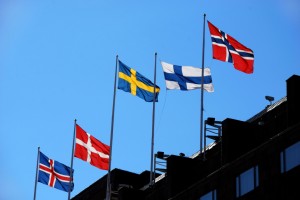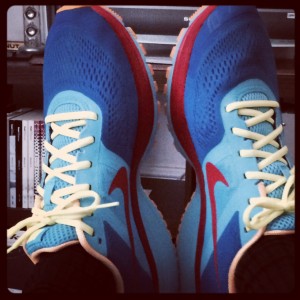Happiness, Brand, and Innovation

World leaders.
Are Finland, Sweden, and Switzerland the three best countries in the world? You might think so based on the latest rounds of research.
In the past, I’ve reported on the World Happiness Report (WHR) and the Global Innovation Index (GII). Both studies are produced regularly and measure a country’s ability to promote specific outcomes. The WHR measures how happy a country’s citizens are and why. The GII measures how effectively a country promotes and protects innovation, especially in regards to scientific and technical innovation.
In a previous article, I compared happiness and innovation. There seems to be a connection, though it’s difficult to say whether happiness promotes innovation or vice versa. Or perhaps some hidden, third variable promotes both. (By the way, I’ve also written about how happiness is measured).
This year, in addition to the updated versions of WHR and GII, I’ve added another — FutureBrand’s Country Brand Index (CBI) — that measures the strength of a country’s brand. Now in its eighth edition, CBI asks citizens of many countries to judge the most attractive countries to produce “future-positive predictions”. WHR and GII aim to measure the actual phenomenon — either happiness or innovation. CBI measures perceptions; how is a country perceived by citizens of other countries.
Putting together the three studies reveals a great deal of overlap. In the table below, I’ve listed the top ten countries in each report. Countries that make the top ten in all three studies are in red. Countries that reach the top ten in two studies are in blue. Countries that make the list in one study are in purple.
Switzerland is ranked number one in the CBI and GII studies and number three in the WHR study. It’s happy and innovative and has a positive reputation.
All of the Nordic countries — Denmark, Finland, Iceland, Norway, and Sweden — make at least one of the top ten lists. Sweden and Finland make all three. Denmark and Norway make two. Tiny Iceland makes one.
The USA makes the top ten in brand and innovation but ranks only 17th in happiness.
The lists are dominated by European Protestant countries or their offspring. Asia is represented by only three countries — Hong Kong, Japan, and Singapore. African and Latin American countries don’t make any of the top ten lists. The degree of overlap makes me wonder exactly what we’re measuring in these studies. It could be that happiness, innovation, and brand power are intimately related and that these studies measure the strength of the relationship. On the other hand, this could be an example of cultural bias. Or it could be a halo effect. Countries that are successful in one area may be viewed as successful in other areas as well. Of course, the reverse may also be true.
I plan to delve into each of these studies more closely in the future. In the meantime, please review the table below and help me sort out the relationship between the variables and the countries. What causes what?
| WHR 2013 | CBI 2013 | GII 2013 | ||
| 1 | Denmark | Switzerland | Switzerland | |
| 2 | Norway | Canada | Sweden | |
| 3 | Switzerland | Japan | UK | |
| 4 | Netherlands | Sweden | Netherlands | |
| 5 | Sweden | New Zealand | USA | |
| 6 | Canada | Australia | Finland | |
| 7 | Finland | Germany | Hong Kong | |
| 8 | Austria | USA | Singapore | |
| 9 | Iceland | Finland | Denmark | |
| 10 | Australia | Norway | Ireland |
Gaudy Is The New Black – Mass Customization

Gaudy is the new black.
I recently designed a new pair of running shoes. I went to the NikeID website and configured approximately a dozen different components to create shoes in my custom colors. Nike assembled the shoes and delivered them to my doorstep in about a week. The price was roughly five percent higher than a standard shoe in standard colors at the mall.
Why did I design my own shoes? Well, partially because I could. Nike’s website has easy-to-use tools that let me mix and match colors until I got exactly what I wanted. I chose to go gaudy because that seems to be the trend today. The downside – Suellen is somewhat embarrassed to be seen with me. The upside – they’re great conversation starters, especially with women. Men, not so much.
Note that I only configured my new shoes. I didn’t custom build them. The shoe is an Air Pegasus, a standard, off-the-shelf model. I couldn’t design my own tread pattern or insole, for instance. Nor could I fool with the sizes. My feet are not the same size and I’d love to order shoes that fit each foot. Not yet. All I could do was take a standard template in a standard size and customize the colors.
I chose Nikes because I know exactly what size to order. I’m sure that all the athletic shoe companies have similar configurators but I’m leery about ordering the wrong size. I’ll probably stick with Nikes until better sizing systems come along.
According to McKinsey, in their latest report on mass customization, I probably won’t have to wait long. In fact, I should be able to do more customizing and less configuring in a number of product categories. Here are some examples drawn from the McKinsey report.
Sizing and virtual try-ons – several companies, including Styku and Constrvct, will scan your body (or parts of it) to create very precise 3D models. The system then projects the model on your computer and you “try on” clothes, shoes, etc. (Suellen used a simple version of this when ordering her Warby Parker glasses).
Create your own products – Starbucks allows you to create your own coffee drinks at frappuccino.com. At Adagio Teas, you can create your own tea that the company ships to you. You can keep it a secret (Travis Tea?) or offer it to the public. If other people order it, you get points toward future purchases. At Shoes of Prey, you can configure virtually any kind of shoe, not just running shoes. In all these examples, you get what you want but the vendor also gets more than just a sale. They also get valuable insights into market trends and what’s popular where.
Recommendation engines – I’m used to Amazon suggesting that if I like Book X, I’ll also enjoy Book Y. That’s nice. But, how about a recommendation engine that will help me build a new product? Why couldn’t the NikeID system tell me, for instance, that red and orange don’t go well together? McKinsey highlights a company called Chocri, that helps you build custom chocolate bars. If you create a bar with strawberry bits, it will recommend complementary flavors like cinnamon, almonds, or edible gold flakes. Who knew?
So, we’ll have much more choice in the near future. With flexible software to manage inventories and programmable robots to assemble the goods, custom-made products probably won’t cost much more than today’s off-the-shelf goods. That should create clear benefits for both suppliers and customers. It won’t be long. In fact, we may see many of the solutions even before I wear out my gaudy new shoes.
Products As A Service – The Circular Economy

Why buy when you can rent?
I’ve bought several products recently without really buying them. Rather than buying the product, I bought the benefits. The manufacturer still owns the product. In the future, the manufacturer may take the product back, replace it with a newer, better product, and recycle the original product.
I get two sets of benefits. First, I get the benefit of whatever the product offers. Second, I get the benefit of staying current with the latest technology. (This is sometimes known as future-proofing). The manufacturer also gets two benefits. They get a steady income stream as I rent the first product. And, when they upgrade me, the manufacturer can refurbish my original product and resell it.
I bought my new smart phone this way last December. I pay a monthly fee to use the hardware. The fee also gives me the right to upgrade to a new phone in 12 months, with no additional charge. I simply give my current phone back to the manufacturer and walk out with the new phone. The manufacturer takes my old phone back, refurbishes it, and “sells” it to someone else.
In the software world, this is known as an “as-a-service” offering. Workday, for instance, offers software-as-a-service for human resources applications. Companies don’t buy the software. Rather they buy access to the software as it runs on the cloud. Behind the scenes, Workday can upgrade to new releases or new technology transparently.
Amazon similarly offers platform-as-a-service through its Amazon Web Services arm. Amazon has built a huge array of computers; anyone can access it by the hour, or day, or week, or year. You just pay for what you use. I now have the power of a supercomputer at my fingertips (for a brief period).
Outside the software world, this concept is more generally known as the circular economy. The idea is that a manufacturer sells a product and expects that it will circle back at some time in the future. The manufacturer can capitalize on the remaining economic value within the product by refurbishing, reselling, or recycling it.
Phillips Electronics seems to be one of the leading practitioners of the circular art. In an interview with McKinsey, the Phillips CEO, Frans van Houten discusses some of their projects. For instance, Phillips has a contract with Buenos Aires to replace 125,00 streetlights with advanced LED devices. Buenos Aires is buying the light, not the devices. Phillips can upgrade the devices in the future to capitalize on energy-saving enhancements. Conceivably, Phillips could sell the current LED devices to other cities.
As van Houten point out, the circular economy also changes the way product designers think. They’re no longer designing a product that they’ll never see again. In all likelihood, the product will circle back to them. So, they design not only for function, but also for longevity and reuse. That can mean better margins for the manufacturer as well as lower costs for the customer.
Best of all, perhaps, the circular economy also means that fewer products wind up in landfills. Rather than designing for obsolescence, circular companies are designing products that will live multiple lives. That can only be good for us and the world we live in.
Good For Bad

Rust never sleeps.
In The Magic Mountain, young Hans Castorp travels up the mountain to visit his cousin, Joachim, who is recuperating in a tuberculosis sanatorium. Joachim’s doctor tells Hans that — with its crisp, thin, dry air — the mountain is good for tuberculosis.
Hans enjoys the cosmopolitan crowd that inhabits the sanatorium and dallies a bit too long. He contracts tuberculosis himself. Dismayed, he consults with the doctor again. The doctor is nonplussed. “But I told you”, he says, “that the mountain is good for tuberculosis”.
Slice an apple in half and you’ll see the results of oxidation. The newly exposed flesh turns brown and dries out quickly as it oxidizes. If you rub lemon juice on the apple, however, the flesh stays moist and firm. The juice prevents oxidation.
Oxidation is essentially rust. Just as I don’t like rust on my bicycle, I don’t like it in my body either. I keep my bike well lubricated and I try to do the same for my body. Antioxidants help prevent rust in my body. That’s a good thing, right?
Like the magic mountain, however, antioxidants can be good for bad things as well. Science reports on a Swedish study that finds that “moderate doses of two widely used antioxidants spur the growth of early lung tumors in mice.” I’ve always viewed antioxidants as good for good things. It may be that they’re good for bad things as well. Cancer may not like rust any more than the rest of us do.
Recently we’ve seen a furor in the United States about the government spying on citizens. I believe that restricting the government’s ability to spy on us is a good program. Privacy is a valuable right and we should protect it. Those same restrictions, however, could be good for terrorists who want to attack us. In other words, restrictions of government spying could be good for bad things as well.
When the cure causes the disease, medical researchers call it iatrogenic. When a good program causes bad things to happen, we may refer to them as unintended consequences or, more recently, collateral damage.
I suspect that good programs promote bad things (as well as good things) more often than we think. The trick is to get the balance right, to create remedies and cures that promote maximal goodness and minimal badness. As we make our decisions, however, we need to remember that no program, no matter how well conceived, will promote only good. Unintended consequences will always be with us. We need to account for them. As Neil Young taught us, rust never sleeps.
Better Decisions for Your Company – 1
 Several years ago Marcia Blenko, Michael Mankins, and Paul Rogers (all Bain consultants) wrote a book called Decide & Deliver – 5 Steps to Breakthrough Performance in Your Organization. Recently, they converted it into a white paper. Since their research provides important clues for improving decision making, I’d like to summarize it today and tomorrow. I hope it will encourage you to read more – it’s useful stuff.
Several years ago Marcia Blenko, Michael Mankins, and Paul Rogers (all Bain consultants) wrote a book called Decide & Deliver – 5 Steps to Breakthrough Performance in Your Organization. Recently, they converted it into a white paper. Since their research provides important clues for improving decision making, I’d like to summarize it today and tomorrow. I hope it will encourage you to read more – it’s useful stuff.
Step 1 – Score Your Organization. Most of us don’t give our organizations a grade for the quality of our decisions. But we rate ourselves on most everything else, so why not decision making? The authors suggest a broad survey of managers and employees, followed by face-to-face interviews. Ask four basic questions:
- Quality — How often do you choose the right course of action?
- Speed — How quickly do you make decisions versus competitors?
- Yield – How often do you execute decisions as intended?
- Effort – Do you put the right amount of effort into making and executing decisions?
These are simple, straightforward questions but I suspect that most of our organizations don’t give much thought to them. Once you’ve gathered the information, Bain has a database of companies to benchmark against.
Step 2 – Focus on Key Decisions. You can’t evaluate every decision, so identify the critical ones in two different categories: 1) Big, high-value strategic choices – most of these are obvious. 2) Operating decisions that “are made and remade frequently and generate a lot of value over time.” These are less obvious but might include things like merchandising decisions. Companies often make millions of merchandising decisions; shifting even a small percentage from “bad” to “good” can make a huge difference.
To identify the most important decisions, consider two key attributes:
- Value at stake – don’t forget to multiply value by frequency. Doing so will help you identify high-value operating decisions.
- Degree of management attention required – can the decision be pushed down the hierarchy and out toward the customer or does it percolate upward? Decisions that require a lot of attention often provide “greater scope for improvement.”
The authors also suggest using the Decision X-Ray. When a decision goes bad, don’t just fix it. Study how the decision was made and identify the factors that caused it to fail. Then apply the lessons to future decisions.
Step 3 – Make Decisions Work. Four elements here: What, Who, How, and When.
- Clarify the What – don’t just focus on “whether-or-not” decisions – as in, “We need to decide whether or not to buy Company X”. Expand the decision, as in “What’s the best way to invest our capital?”
- Determine the Who – consider the acronym RAPID and identify people who need to Recommend, others who provide Input, others who need to buy into or Agree to the decision, someone(s) to make the final Decision, and others who Perform or execute the decision.
- Understand the How – how will you make the decision … by popular vote? By consensus? By a key executive?
- Make the When explicit – “A schedule ensures that decisions are quickly followed by action so that things can happen rapidly and the hurdle to reopen the decisions is high.”
Tomorrow: Steps 4 and 5: Build an Organization and Embed Decision Capabilities.